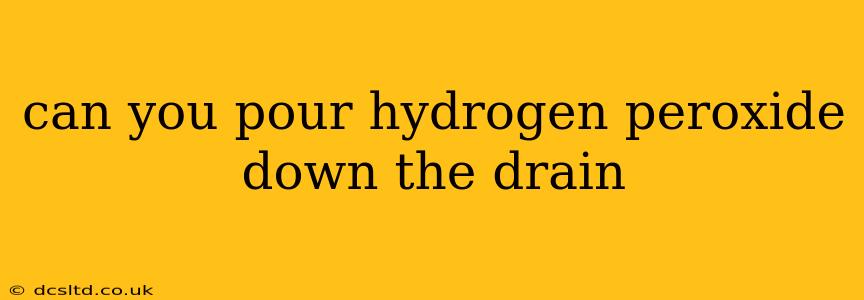Can You Pour Hydrogen Peroxide Down the Drain?
The short answer is: it depends. While hydrogen peroxide is generally considered environmentally friendly compared to many other household chemicals, pouring it down the drain isn't always the best practice. The impact depends on several factors, including the concentration of the peroxide, the amount you're disposing of, and your local plumbing and sewage systems.
Here's a more detailed breakdown to help you make the right decision:
What Happens When You Pour Hydrogen Peroxide Down the Drain?
Low concentrations of hydrogen peroxide (like the 3% solution you find in drugstores) will generally decompose into water and oxygen. This process is relatively harmless to your pipes and the environment. The oxygen released might even help to slightly oxygenate the water in your sewage system, though the effect is negligible on a large scale.
However, higher concentrations (e.g., solutions above 6%) can be corrosive and potentially damage your pipes over time. They also pose a greater risk to aquatic life if they reach untreated waterways.
What Concentration of Hydrogen Peroxide Do I Have?
This is the crucial question. Always check the label of your hydrogen peroxide bottle. The concentration will be clearly stated as a percentage. If it's 3%, you likely don't need to worry about significant negative environmental impact from pouring small amounts down the drain. Larger amounts, however, are best handled differently (see below).
What Happens if I Pour a Large Amount of Hydrogen Peroxide Down the Drain?
Even low concentrations, when disposed of in large quantities, can overwhelm the decomposition process in your pipes. This could lead to issues like:
- Foaming: The decomposition reaction produces oxygen, which can lead to significant foaming in your drains. This foam can back up your pipes and cause clogs.
- Damage to septic systems: Higher concentrations can harm the beneficial bacteria in septic systems, hindering their ability to break down waste.
What are the Alternatives to Pouring Hydrogen Peroxide Down the Drain?
For larger amounts or higher concentrations of hydrogen peroxide, it's best to adopt a safer disposal method:
- Dilute and slowly pour: For moderate amounts of higher-concentration peroxide, dilute it significantly with water before slowly pouring it down the drain. Ensure the dilution is sufficient to minimize any potential negative effects.
- Check your local regulations: Your local waste management authority may have specific guidelines or collection programs for disposing of chemicals like hydrogen peroxide. Contact them to inquire about the proper disposal method in your area.
Can Hydrogen Peroxide Harm My Pipes?
Low concentrations of hydrogen peroxide (3%) are generally not harmful to standard plumbing materials. However, higher concentrations, especially when combined with other chemicals, can be corrosive and potentially damage pipes over prolonged periods.
Is Hydrogen Peroxide Safe for the Environment?
Low concentrations decompose harmlessly into water and oxygen. However, high concentrations can harm aquatic life if released into untreated waterways. It's always best to minimize the amount entering the sewage system.
In conclusion, while small amounts of low-concentration (3%) hydrogen peroxide are generally fine to pour down the drain, it's always best to err on the side of caution. Dilute higher concentrations, dispose of large quantities responsibly, and consult local regulations to ensure you're protecting your plumbing and the environment.
